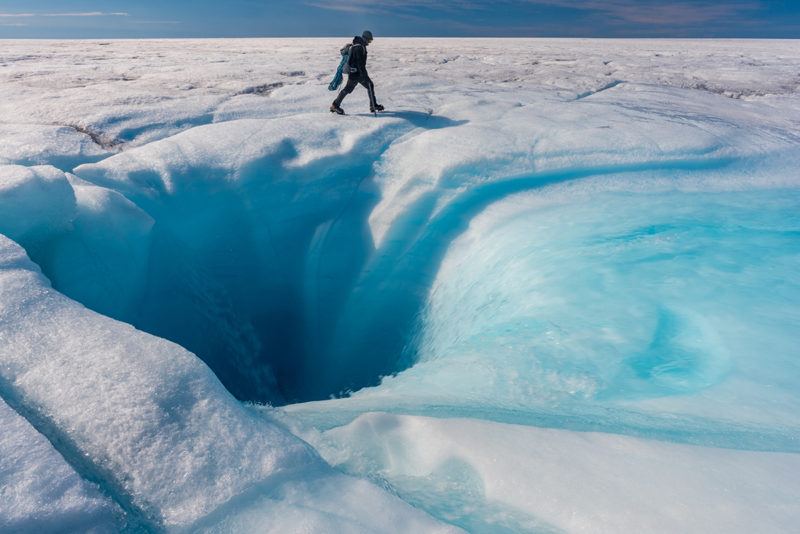
Bigger-than-expected Greenland ice caves could speed ice sheet movement into ocean
Geoscientist Matt Covington ascends out of an ice cave, called a moulin, on the Greenland ice sheet in October 2019. One of just a few scientists exploring Greenland’s moulins, he is working to understand how melting ice affects the glacier’s movement. (Photo by Jason Gulley)
Matt Covington hung from the edge of a Greenland ice cave, peering into its depths. He couldn’t see the bottom, hundreds of meters below—but he could hear it: running water and the occasional crash of broken ice plummeting into the darkness.
“In that big, cathedral-like setting, it’s very echoey,” said Covington, a University of Arkansas geoscientist and seasoned caver. “Those booming sounds are intimidating.”
On that unseasonably warm October day in 2019, the ice was melting around him. How that might affect the glacier’s fate in a warming climate is what he and colleague Jason Gulley, a glacier expert at the University of South Florida, risk personal safety to find out. Covington discussed their research Oct. 24 during the Council for the Advancement of Science Writing’s New Horizons in Science briefings at the ScienceWriters2022 conference in Memphis, Tenn.
The 700,000-cubic-mile Greenland ice sheet is the largest contributor to global sea level rise. Over half of that contribution comes from surface melt, and the rest from ice sliding into the ocean or breaking off and falling in. In 2019, Covington and his team were exploring a moulin, a cave that forms when meltwater drains into the ice. The structures act as arteries of the glacier, carrying meltwater from the surface to the bottom, where the water buoys the ice on its slow path toward the ocean.

The Greenland ice sheet’s moulins are much larger and can hold more meltwater than previously thought, the team found. That can lead to increased water pressure under the sheet, pushing it into the ocean faster. So far, the team has thoroughly explored just two of the thousands of moulins covering the glacier, however, and their findings may not hold true across the entire Greenland ice sheet.
They may have a while to wait before they can study more caves. Remote expeditions are dangerous and expensive—each requires multiple helicopter round trips costing tens of thousands of dollars to transport people and gear between Covington’s research site and the nearest town in Greenland, and the work leaves the team cut off from civilization for weeks at a time.
Because of the resources and training required and the risk involved, Covington and his team are among a very small number of scientists doing this type of work. Their research combines geographic exploration at one of the planet’s last uncharted frontiers with on-the-ground scientific measurements.
Chills, thrills—and extreme challenges

Covington’s lifetime of exploring helped prepare him for the rigors of working in ice caves. His first time in a wild cave—one not developed for tourists—was at age six, during a family trip to Devil’s Den Cave in Arkansas. By the time he finished graduate school in his late twenties, he had spent what adds up to more than a year underground, mapping cave systems all over the world.
He is drawn to caves that offer a challenge—and there’s no shortage of that on his research trips. On that warm day in 2019, pouring meltwater threatened the integrity of the ice to which team members anchored their harnesses as they rappelled down to a study site. On another expedition, they were snowed in at their campsite for 10 days, unable to venture far from their tents for fear of falling into a hidden crevasse. Later the snow blew into the moulin while the team was working, creating blizzard-like conditions inside the cave.
Mental hardships also come with the work. Covington has a fear of heights, but has learned to deal with it by focusing on correctly rigging the team’s many safety devices.
He continues to take the risks because the on-site data his team collects can help make climate models more accurate. And he gets to explore wild places that offer expansive vistas, peaceful isolation, and glimpses of the Northern Lights.
“The moulin work was the first time where I was able to combine that exploration aspect with a real scientific contribution,” Covington said. “And that’s rewarding.”